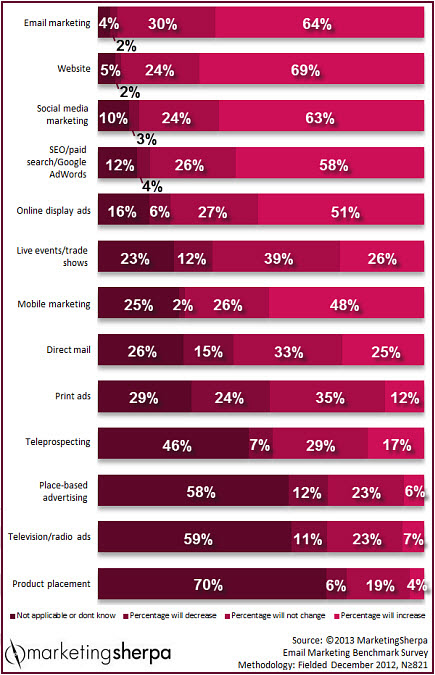Mobile Marketing: How mobile impacts customer awareness
I’ve always felt that the aphorism about true wisdom being a byproduct of first admitting you don’t know everything to be accurate.
When I attended the ClickZ Live conference in Chicago last October, I got the chance to be exposed to some great new content. However, I felt one of the stories still being told was something I’ve been hearing on repeat since 2011. The story I’m talking about is that of mobile marketing and how it is the “wave of the future.”
We here at Sherpa have been preaching the shift in marketing budgets to mobile for years as well — just take a look back at this chart from last April.
Taking a look at some of the mobile channel data
I don’t think there’s any argument on where the industry is going anymore. That being said, I do feel that some of the most convincing data about focus on mobile is being under-utilized by marketers, or even worse, it’s being used by marketers to justify decisions that are not in the best interest of their business — decisions that will not show the best ROI and could be spent more effectively in other channels.
Working on partnerships in different industries over the past several years, I have seen both the good side and bad side of the mobile revolution, while making plenty of mistakes along the way. Seeing just how terrible mobile conversion rates can be compared to other channels is often disheartening.
It’s not enough to just say “mobile is the future.” We need something more actionable. Marketers admitting as an industry that we don’t know everything is the first step.
Do we know that mobile marketing is working?
What the most refreshing to me about ClickZ was the day two keynote by Greg Stuart, CEO, Mobile Marketing Association, titled, “Finally, we know for sure mobile marketing works.” This keynote admitted a core problem marketers are facing directly in its title:
How do we know mobile is working?
Greg presented a very compelling case study in a partnership with AT&T that showed how the MMA was able to prove the effectiveness of mobile advertising and the potential it could bring if introduced into the marketing mix (budget) more effectively.
The key takeaway from the study revealed that mobile delivered almost twice the impact per dollar spent on building customer awareness compared to national TV. The best part of the study? It was backed by real data.
I definitely recommend taking the time to read the case study on the Mobile Marketing Association site when you have a chance.
While case studies perform an integral role in justifying the effectiveness of mobile marketing, you need to ensure that you are not just “taking other people’s word” and that allocating more money to your mobile budget will actually help boost your performance.
The first, and potentially most important, step to building your case for an expanded mobile budget involves a realistic look at your site’s current performance on mobile devices compared to other mediums such as desktop.
Luckily, most analytics platforms have pre-made segments that allow you to easily filter desktop, tablet and smartphone data and compare them against one another. If you have ecommerce and goal funnels set up, you can further understand how your site is performing in terms of conversions. Don’t be surprised if the picture isn’t very pretty, but at least you’ll now have a solid understanding of where the opportunity really exists.
A few metrics to track when getting started (and that you should probably have reports for anyways):
- Conversion rate
- Daily users
- Average time on site
- Pages per visit
- Bounce rate
- Users’ flow
After the basics, you should consider what metrics might be more indicative of user behavior on mobile devices and may be more specific to your industry.
I recall working for a research partner that focused on travel services and events in a particular city. By looking at the pages as well as location reports, we validated our hypothesis that the vast majority of mobile users were accessing content when they were already in the city via their mobile devices versus using a mobile device to plan their trip in advance.
This proved a need for a heavier focus for on-demand, daily event-based and map-based content in the mobile space versus the desktop space, where visitors were likely planning a trip in advance.
The behavioral metrics you look at will depend on your industry and the objective of your site, but you might be surprised about what they reveal and how that will translate to a mobile opportunity.
Another resource that I highly recommend is Avinash Kaushik’s posts about behavioral metrics and measurement.
Now that you’ve discovered where the mobile opportunity exists for your business, it’s time to jump into action with your first mobile campaign. Whether it’s a Google AdSense campaign, in-app promotion or something else, make sure you limit your downside risk and intelligently measure your ROI to record your results so that you can accurately display the performance of your campaign.
Start small with a clearly defined framework and set of metrics for judging success. I’m not going to tackle attribution modeling in this post, but it’s definitely something you need to be aware of, and for now, you can get more information on it here — Multi-Channel Attribution: Definitions, Models and a Reality Check.
You might also like
A/B Testing: How to improve already effective marketing (and win a ticket to Email Summit in Vegas) [More from the blogs]
Marketing Research Chart: 2012 budgets suggest a new role for email marketing [MarketingSherpa chart]
Mobile Marketing: 6 mobile marketing challenges every marketer faces [More from the blogs]
Mobile Marketing: Optimizing the evolving landscape of mobile email marketing [MarketingSherpa webinar archive]
Mobile Marketing: 3 tips from ModCloth on mobile app engagement [More from the blogs]
Categories: Mobile marketing budget, mobile marketing










